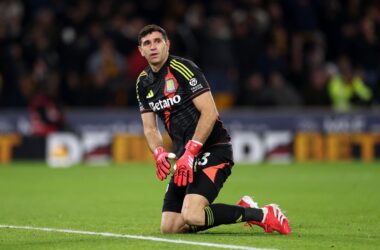As Arsenal aim to end their 22-year Premier League title drought in the 2025/26 season, Mikel Arteta’s search for a prolific striker remains a top priority.
The Gunners’ attacking struggles, exacerbated by injuries to Kai Havertz and Gabriel Jesus last season, have highlighted the need for a reliable No. 9 to complement their dynamic squad.
Two standout candidates have emerged: RB Leipzig’s Benjamin Šeško and Sporting CP’s Viktor Gyökeres.
While recent reports suggest Arsenal are leaning toward Gyökeres, this analysis evaluates both players based on their fit for Arteta’s system, immediate impact, long-term potential, and alignment with Arsenal’s ambitions, ultimately arguing that Šeško is the better choice for Arsenal’s long-term project despite Gyökeres’ edge in immediate output.
1. Tactical Fit for Arteta’s 4-3-3 System
Mikel Arteta’s preferred 4-3-3 formation demands a striker who can press intelligently, link play with wingers like Bukayo Saka and Gabriel Martinelli, and finish chances in a high-pressing, possession-based system. Benjamin Šeško, at 22, offers a versatile skill set that aligns seamlessly with these requirements.
Standing at 6’4”, the Slovenian combines physicality with technical finesse, excelling in hold-up play, aerial duels (3.2 won per game in the 2024/25 Bundesliga), and precise finishing (14 goals in 31 Bundesliga games last season).
His ability to drop deep and facilitate play suits Arteta’s fluid attacking structure, as seen in his interplay with Leipzig’s creative midfielders like Dani Olmo. Šeško’s pressing intensity (1.8 pressures per game) also complements Arsenal’s high-pressing philosophy, making him a natural fit alongside Declan Rice and Martin Ødegaard in midfield.
Viktor Gyökeres, 27, is a more direct, physical striker whose 54 goals in 52 appearances for Sporting CP in 2024/25 showcase his lethal finishing. His pace and power make him effective in transition, thriving in Sporting’s counter-attacking style under Ruben Amorim.
However, his reliance on open spaces and weaker back-to-goal play (0.9 successful take-ons per game compared to Šeško’s 1.4) may limit his effectiveness in Arsenal’s system, which often faces deep-lying defenses.
Also, Gyökeres’ “box movement is subpar” for Arsenal’s needs, and his game “relies on running the left channel in tons of open space,” which is less common in the Premier League.
While His pressing aligns with Arteta’s demands, his less refined link-up play could disrupt Arsenal’s intricate attacking patterns, making Šeško the better tactical fit.
2. Immediate Impact vs. Long-Term Potential
Arsenal’s third consecutive second-place finish in the Premier League has intensified pressure on Arteta to deliver silverware in 2025/26, prompting some to favor Gyökeres for his immediate impact. His remarkable 97 goals in 102 appearances for Sporting since 2023 demonstrate his readiness to deliver goals now.
Reports indicate Arsenal’s shift to Gyökeres was driven by his “win-now” profile, with Arteta and sporting director Andrea Berta prioritizing a proven goal-scorer after stalled talks with Šeško due to RB Leipzig’s €80m demands.
Gyökeres’ experience in important matches, including the Champions League, and his reported willingness to join Arsenal (with personal terms agreed) make him a low-risk option for instant contributions.
However, Šeško offers greater long-term potential, which aligns with Arsenal’s youth-focused project under Arteta. At 22, Šeško is five years younger than Gyökeres and already producing at an elite level (14 goals, 7 assists in 2024/25 Bundesliga).
His ceiling is considered higher, with CIES Football Observatory valuing him at €94-122m compared to Gyökeres’ €60-79m, reflecting his market potential. Šeško’s raw attributes—speed, height, and technical growth—suggest he could develop into a world-class striker under Arteta’s coaching, much like Gabriel Jesus evolved at Manchester City.
While Šeško’s all-round game is still raw, his adaptability and upside make him a better investment for a club building a dynasty. With Arsenal’s squad already featuring young stars like Saka and Ødegaard, Šeško’s age profile ensures longevity and resale value, outweighing Gyökeres’ short-term edge.
3. Premier League Adaptation and Risk
Gyökeres’ prior experience in England raises concerns about his adaptability to the Premier League. During his time at Brighton (2018-2021), he failed to score in eight Premier League appearances, and while he excelled at Coventry City in the Championship (21 goals in 46 games in 2022/23), the leap to the Premier League’s intensity remains untested.
His prolific form in Portugal’s Primeira Liga, a less competitive league, fuels skepticism about his translatability, with several reports noting that Gyökeres’ “uncoachable chaos” may not suit Arsenal’s structured system.
Arsenal’s history of signing players from less competitive leagues (e.g., Leandro Trossard’s success vs. Mykhailo Mudryk’s struggles) underscores the risk of banking on Gyökeres’ adjustment.
Šeško, while untested in the Premier League, has thrived in the Bundesliga, a league closer in intensity and tactical demands to England’s top flight.
His 14 goals against robust defenses like Bayern Munich and Borussia Dortmund demonstrate his ability to perform under pressure. Šeško’s physicality (6’4”, 85kg) and pace (top speed of 35.7 km/h) suggest he can handle the Premier League’s physical demands, and his youth offers room for adaptation under Arteta’s guidance.
4. Financial Considerations
Arsenal’s transfer budget, constrained by Profitability and Sustainability Rules (PSR), makes cost-effectiveness critical.
Gyökeres’ reported €69m (£61m upfront plus £8m in add-ons) transfer fee is slightly lower than Šeško’s €80m valuation, and his willingness to “sacrifice” salary to join Arsenal eases financial negotiations.
Sporting CP’s openness to a deal, coupled with Gyökeres’ strained relationship with the club, makes him a more attainable target. Arsenal’s urgency to finalize a signing before their pre-season tour of Asia, as emphasized by Arteta’s reported two-week deadline, further favors Gyökeres.
However, Šeško’s higher valuation reflects his long-term potential and marketability, making him a strategic investment. RB Leipzig’s firm stance on €80m, with €40m upfront, stalled talks, but Arsenal’s failure to negotiate a lower fee may reflect a lack of persistence rather than Šeško’s unsuitability.
Šeško’s contract extension with Leipzig until 2029 complicates matters, but his agent’s comments suggest openness to a future move if terms align. Given Arsenal’s long-term interest in Šeško (dating back to last summer), revisiting negotiations could secure a transformative talent at a price justified by his ceiling.
Wrapping Up
Benjamin Šeško is the better fit for Mikel Arteta’s Arsenal due to his tactical alignment with the 4-3-3 system, long-term potential, and proven performance in a top-five league.
His versatility, youth (22), and high ceiling make him a future-proof investment for a club building a dynasty around young talents like Saka and Ødegaard.
While Viktor Gyökeres offers immediate goal-scoring prowess and a lower transfer fee, his unproven Premier League record and reliance on transitional play pose risks for Arsenal’s structured system.
Šeško’s adaptability, physicality, and potential to become a world-class striker outweigh Gyökeres’ short-term advantages, especially for a club aiming to dominate for years to come.










